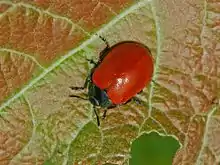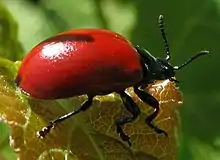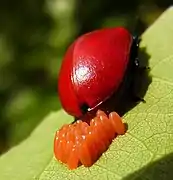Chrysomela populi
Chrysomela populi is a species of broad-shouldered leaf beetle belonging to the family Chrysomelidae, subfamily Chrysomelinae.
| Chrysomela populi | |
|---|---|
 | |
| Dorsal view | |
| Scientific classification | |
| Domain: | Eukaryota |
| Kingdom: | Animalia |
| Phylum: | Arthropoda |
| Class: | Insecta |
| Order: | Coleoptera |
| Infraorder: | Cucujiformia |
| Family: | Chrysomelidae |
| Subfamily: | Chrysomelinae |
| Tribe: | Chrysomelini |
| Genus: | Chrysomela |
| Species: | C. populi |
| Binomial name | |
| Chrysomela populi | |
| Synonyms[1] | |
| |
Distribution
This species is one of the most widespread and frequent species of leaf beetles from the subfamily Chrysomelinae. These beetles can be found in most of Europe (Austria, Belgium, Czech Republic, France, Germany, Italy, Luxembourg, Poland, Slovakia, Switzerland),[2] in the Palearctic realm and in the Oriental realm (Caucasus, Pakistan, Siberia, Kazakhstan, Central Asia, Far East of Russia, China and Japan).[3][4]

Habitat
These beetles mainly inhabit coniferous, mixed and broad-leaved forests, forest fringes and dry meadows with poplars and willow trees.[3][5]
Description
Adult description
Chrysomela populi can reach a length of about 9–13 mm.[3][5] The female is slightly larger than the male. These beetles show a black, dark blue or dark green body, that is round and ladybird-like. Head and pronotum are black, while elytra is bright red, with a black stain at the base.[5] Some beetles come as orange coloured.[3][7]
It can be distinguished from Chrysolina grossa by its shorter antennae and less estensive pronotum. It is also rather similar to Chrysomela saliceti and Chrysomela tremula.
Biology
Adults can be found from April to October.[5] Females lay eggs in Spring, in small, irregular clusters of up to 20-30 eggs. This species has 2 to 3 generations per year. Larvae of the last generation overwinter in the litter under the leaves. Both the larvae and the beetles live and feed on young leaves of various plants of the Salicaceae species, especially Populus and Salix species.[4][3][5][8] Adults may emit a red, highly-smelling, repellent liquid, obtained from the salicylic acid contained in their food plants.
Gallery
 Mating pair
Mating pair Laying of eggs
Laying of eggs_larvae%252C_Arnhem%252C_the_Netherlands.jpg.webp) Larvae
Larvae.JPG.webp) Pupa. Dorsal view
Pupa. Dorsal view
References
- Kippenberg, H. (2010). "Subfamily Chrysomelinae Latreille, 1802". In Löbl, I.; Smetana, A. (eds.). Catalogue of Palaearctic Coleoptera. Volume 6. Chrysomeloidea. Stenstrup, Denmark: Apollo Books. pp. 390–443. ISBN 978-87-88757-84-2.
- Fauna europaea
- Bukejs, Andris. On Latvian Chrysomelinae (Coleoptera: Chrysomelidae): 2. Genus Chrysomela Linnaeus, 1758
- Urban, J. Occurrence, bionomics and harmfulness of Chrysomela populi L. (Coleoptera, Chrysomelidae Journal of Forest Science. — 2006. — Vol. 52, no. 6
- UK Safari
- Larvae description
- Orange colour
- Sylvie La Spina, Jean-Claude Gregoire, Patrick Mertens & CharlesDe-Canniere - Impact of poplar water status on leaf-beetle (Chrysomela populi) survival and feeding - Annals of Forest Science. — 2010. — Vol. 67. — P. 209. DOI:10.1051/forest/2009102